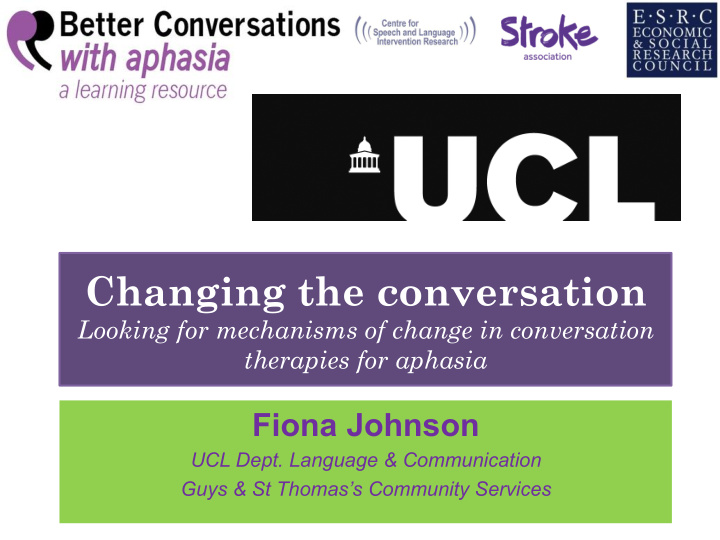



Changing the conversation Looking for mechanisms of change in conversation therapies for aphasia Fiona Johnson UCL Dept. Language & Communication Guys & St Thomas’s Community Services ¡
Background ¡to ¡research ¡ Be$er ¡ Own ¡interests ¡in ¡ Conversa,ons ¡with ¡ implementa,on ¡ Aphasia ¡project ¡ MRC ¡guidelines ¡for ¡ Behaviour ¡change ¡ developing ¡& ¡ research ¡ (Health ¡ evalua,ng ¡complex ¡ Psychology) ¡ interven,ons ¡ (2008) ¡
Principles ¡of ¡behaviour ¡change ¡ ¡ • ‘Behaviour’ ¡applies ¡to ¡ ¡all ¡ac,ons ¡we ¡take ¡ ¡ • The ¡behaviours ¡we ¡choose ¡are ¡a ¡func,on ¡of ¡a ¡range ¡ of ¡‘ determining’ ¡influences ¡ – E.g. ¡Our ¡skills ¡& ¡opportuni,es ¡for ¡the ¡behaviour, ¡ ¡our ¡aPtudes/beliefs ¡ about ¡the ¡ ¡behaviour ¡ ¡ • Key ¡to ¡changing ¡behaviour ¡is ¡changing ¡the ¡relevant ¡ determinants ¡ (most ¡strongly ¡associated/ ¡predic,ve ¡of ¡ behaviour) ¡ ¡ • Interven,on ¡planning: ¡ – Iden,fying ¡relevant ¡determinants ¡ ¡ – Select ¡interven,on ¡procedures ¡based ¡on ¡rela,onship ¡to ¡determinants ¡
Aims ¡of ¡my ¡study ¡ ¡ • Iden,fy ¡the ¡ determinants ¡of ¡behaviour ¡ speakers ¡use ¡to ¡manage ¡aphasia ¡in ¡ conversa,on ¡ • Conversa,on ¡partners ¡& ¡Speakers ¡with ¡aphasia ¡ • Facilitators ¡& ¡Barriers ¡ ¡ • Consider ¡ evidence ¡ for ¡mechanisms ¡of ¡change ¡ opera,ng ¡in ¡Be$er ¡Conversa,ons ¡with ¡ Aphasia ¡programme ¡ ¡ ¡
COM-‑B ¡Model ¡of ¡Behaviour ¡ ¡ (Michie, ¡van ¡Stalen ¡& ¡West ¡2011) ¡ Behaviour ¡
Methods ¡ • Qualita,ve ¡approach ¡ – Why? ¡ • Exploratory ¡ • Iden,fy ¡& ¡define ¡salient ¡concepts ¡in ¡new ¡field ¡ ¡ • ‘Opportunis,c’ ¡Data ¡Set ¡ – ¡Interviews ¡before ¡and ¡a]er ¡therapy ¡ – Discussions ¡held ¡during ¡therapy ¡ ¡ • Par,cipants ¡from ¡original ¡BCA ¡programme ¡ ¡
Methods ¡ • Framework ¡Analysis ¡ (Richie ¡& ¡Spencer ¡1994; ¡Na,onal ¡Centre ¡for ¡Social ¡ Research) ¡ ¡ ¡ ¡ ¡ ¡ ¡ ¡ • Developing ¡explanatory ¡categories ¡to ¡describe ¡data ¡ • Comparing ¡findings ¡with ¡theory-‑linked ¡model ¡of ¡ behaviour ¡
Findings ¡for ¡presenta,on ¡today: ¡ ¡ Exploring ¡the ¡Role ¡of ¡‘MoDvaDon’ ¡ COM-‑B ¡Aspects ¡of ¡ 1. Focus ¡on ¡data ¡from ¡ ‘MoDvaDon’ ¡ ConversaDon ¡Partners ¡ influencing ¡behaviour ¡ ¡ 2. Summarise ¡evidence ¡for ¡ Social ¡IdenDty ¡ ¡ ¡Beliefs ¡about ¡CapabiliDes ¡(Self-‑ ¡ behavioural ¡determinants ¡ Efficacy) ¡ ¡ rela,ng ¡to ¡‘Mo,va,on’ ¡ Perceived ¡Social ¡Norms ¡ ¡ Beliefs ¡about ¡Consequences ¡ ¡ IntenDons ¡ ¡ 3. Explore ¡evidence ¡for ¡ Goals ¡ ¡ EmoDonal ¡Response ¡ possible ¡ pathways ¡to ¡ ¡ Psychological ¡bias ¡ change ¡ ¡ ¡ Reinforcement ¡
Aspects ¡of ¡‘Mo,va,on’ ¡in ¡the ¡data ¡ How ¡long ¡do ¡I ¡wait? ¡Other ¡ Behaviour ¡chosen ¡for ¡how ¡ people ¡-‑ ¡If ¡I ¡wasn’t ¡saying ¡ speakers ¡believe ¡it ¡serves ¡ anything, ¡and ¡he ¡was ¡ge@ng ¡ Beliefs ¡about ¡ following ¡Goals ¡ ¡ frustrated, ¡might ¡think ¡oh-‑ ¡why ¡ Consequences ¡ ¡ isn’t ¡she ¡asking ¡him. ¡ CommunicaDon ¡ (During ¡Therapy: ¡CP3) ¡ Goals ¡ Reinforcement ¡ Shared ¡understanding ¡ ¡ PWA ¡par,cipa,on ¡in ¡ conversa,on ¡ Conversa,onal ¡flow ¡ Use ¡of ¡accurate, ¡verbal ¡ communica,on ¡ Perceived ¡ Social ¡ ¡ Inten,ons ¡ Norms ¡ Social ¡ Mo,va,on ¡ Protect ¡PWA ¡competence ¡ ¡ ¡ EmoDonal ¡ Minimise ¡frustra,on ¡ ¡ Beliefs ¡ about ¡ Iden,ty ¡ Abili,es ¡ (Self ¡ Efficacy) ¡ ¡It’s ¡just ¡not ¡me. ¡It’s ¡not ¡my ¡ Emo,onal ¡ Psychological ¡ personality. ¡It ¡isn’t ¡that ¡I ¡don’t ¡ Bias ¡ Response ¡ want ¡to ¡write ¡anything ¡down, ¡I ¡ I’ll ¡tell ¡you ¡when ¡I ¡do ¡tend ¡to ¡give ¡up ¡ will ¡move ¡as ¡much ¡as ¡I ¡can, ¡but ¡ and ¡it’s ¡probably ¡not ¡good, ¡is ¡when ¡ I’m ¡not ¡going ¡to ¡stop ¡being ¡me. (During ¡Therapy: ¡CP9) we’re ¡other ¡people. ¡And ¡I ¡get ¡anxious. ¡ ¡ (Pre ¡Therapy: ¡CP6) ¡ ¡
Evidence ¡for ¡Changing ¡MoDvaDons ¡for ¡Behaviour ¡ ¡ CHANGE: ¡ CP: ¡Obviously ¡when ¡you're ¡seeing ¡yourself ¡on ¡video, ¡it ¡does ¡highlight ¡when ¡things ¡are ¡ going ¡well ¡and ¡when ¡things ¡are ¡going ¡wrong. ¡And ¡obviously ¡for ¡myself, ¡iniHally ¡I ¡could ¡see ¡ Beliefs ¡about ¡ where ¡I ¡was ¡leading ¡the ¡conversaHon ¡into ¡a ¡dead ¡end. ¡The ¡video ¡did ¡help ¡especially ¡with ¡ Consequences ¡ that. ¡ of ¡Behaviour ¡ (D5 ¡CP ¡Post ¡Therapy) ¡ ¡ ¡ CP: ¡I ¡think ¡that’s ¡what ¡came ¡out ¡of ¡it. ¡Instead ¡of ¡concentraHng ¡on ¡oh ¡Barry ¡MUST ¡speak, ¡ CHANGE: ¡ we ¡must ¡do ¡this, ¡we ¡must ¡do ¡that.. ¡No. ¡Communicate! ¡ PWA: ¡yeh ¡ ¡Goals ¡for ¡ CP: ¡y’know ¡whichever ¡way. ¡Gestures. ¡WriHng. ¡I ¡think ¡that ¡was ¡the ¡biggest ¡thing. ¡Don’t ¡ Conversa,on ¡ worry ¡about ¡it ¡so ¡much, ¡as ¡long ¡as ¡you ¡communicate… ¡whichever ¡way. ¡ (D6 ¡CP ¡Post ¡Therapy) ¡ ¡ CP: ¡You ¡kinda ¡think ¡well, ¡do ¡we ¡ever ¡have ¡conversaHon? ¡And ¡it ¡made ¡me ¡think: ¡I ¡ don’t ¡think ¡we ¡have ¡much ¡conversaHon. ¡But ¡we ¡do. ¡And ¡we ¡did. ¡ParHcularly ¡when ¡ CHANGE: ¡ we ¡sat ¡down ¡and ¡did ¡the ¡videos ¡– ¡obviously ¡someHmes ¡it ¡was ¡quite ¡difficult ¡but ¡ other ¡Hmes ¡it ¡was ¡quite ¡natural ¡wasn’t ¡it? ¡ Percep,on ¡of ¡ PWA: ¡yup ¡ own ¡skills ¡ CP: ¡And ¡it ¡just ¡showed. ¡We ¡were ¡doing ¡some ¡things ¡that ¡were ¡right. ¡We ¡worked ¡our ¡ way ¡round ¡it. ¡The ¡communicaHon ¡problems. ¡ (D7 ¡CP ¡Post ¡Therapy) ¡
Conclusions ¡ • Behaviour ¡change ¡theory ¡ enables ¡a ¡systema,c ¡analysis ¡of: ¡ ¡ – The ¡influences ¡determining ¡the ¡behaviour ¡targeted ¡by ¡interven,on ¡ ¡ – Possible ¡pathways ¡to ¡changing ¡target ¡behaviours ¡ ¡ • ConversaDon ¡therapy : ¡ ¡ – May ¡operate ¡successfully ¡by ¡addressing ¡ underlying ¡moDvaDons ¡ for ¡ behaviour ¡ (among ¡other ¡areas) ¡ ¡ – Relevant ¡ mechanisms ¡for ¡change ¡ likely ¡to ¡include ¡ • Beliefs ¡about ¡consequences ¡of ¡behaviour ¡ • Goals ¡for ¡conversa,on ¡ • Self ¡efficacy ¡for ¡managing ¡problems ¡caused ¡by ¡aphasia ¡ ¡
Thank ¡you! ¡ ¡ Any ¡Comments? ¡ QuesDons? ¡ ¡ fiona.johnson1@nhs.net ¡ fiona.johnson.09@ucl.ac.uk ¡ ¡ ¡ ¡@msfionajohnson ¡ ¡
Recommend
More recommend